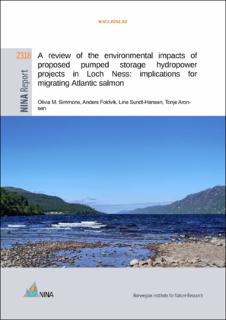A review of the environmental impacts of proposed pumped storage hydropower projects in Loch Ness: implications for migrating Atlantic salmon
Research report

Åpne
Permanent lenke
https://hdl.handle.net/11250/3085192Utgivelsesdato
2023Metadata
Vis full innførselSamlinger
- NINA Rapport/NINA Report [2341]
Sammendrag
Simmons, O.M, Foldvik, A., Sundt-Hansen L., & Aronsen, T. 2023. A review of the environmental impacts of proposed pumped storage hydropower projects in Loch Ness: implications for migrating Atlantic salmon. NINA Report 2318. Norwegian Institute for Nature Research.
The demand for hydropower production is rising as the world transitions towards renewable energies. As such, many new hydropower projects are being planned. In Loch Ness, Scotland, plans for two new pumped storage hydropower (PSH) schemes are under development, which both intend to use the loch as their lower reservoirs. The Ness District Salmon Fishery Board has expressed concern over the potential impacts these new PSH projects may have on the Atlantic salmon population in the Loch Ness Catchment and the broader ecology of the loch. The Atlantic salmon population in this system is already under pressure from several factors, including other already developed hydropower schemes, barriers to their migration such as dams and weirs, exploitation from fisheries, aquaculture, and more. Thus, the objective of this report is to provide a review of the ways PSH schemes can affect the environment, followed by a discussion of how the proposed projects in Loch Ness might affect the salmon population (including some of the knowledge gaps about these effects). Then we provide suggestions for studies to address the identified knowledge gaps and propose some mitigation and offsetting measures to help the Atlantic salmon in Loch Ness. Overall, we found a lack of knowledge about how Atlantic salmon migrate through the loch, which is imperative for understanding how closely they will encounter the proposed projects. We also found a lack of knowledge about how the new PSH schemes might impact the flow patterns and temperature regimes in Loch Ness, which will have implications for migrating salmonids and the broader aquatic community in the loch. We recommend that further research is required to better understand these critical matters.